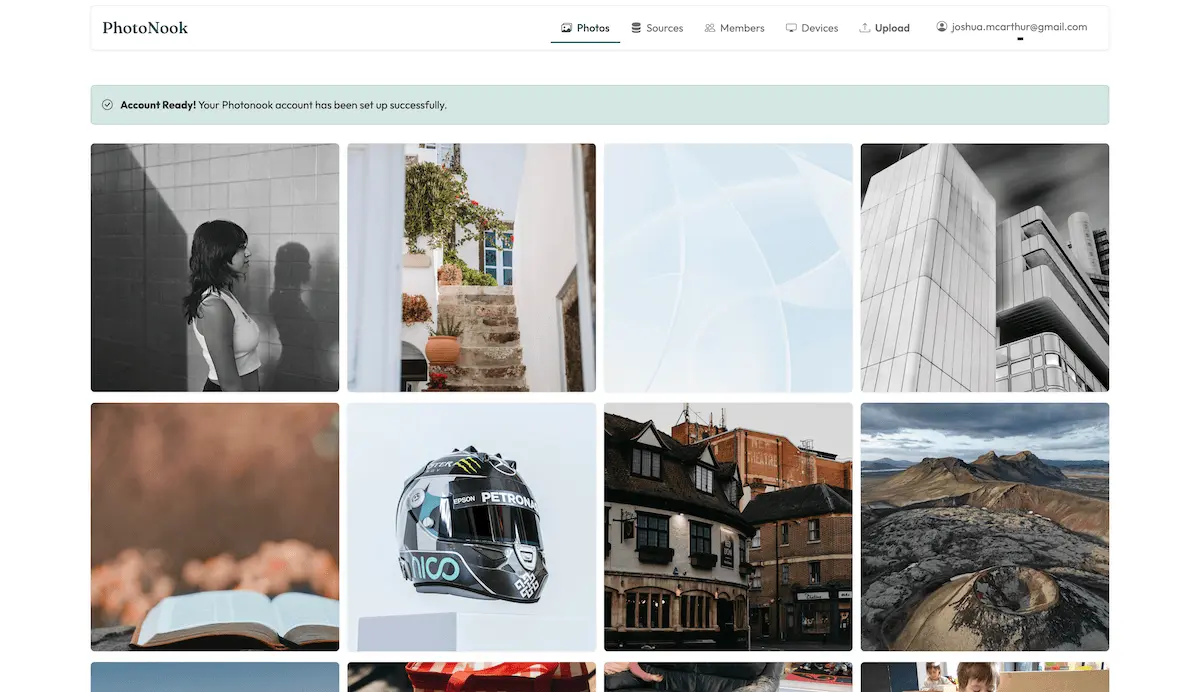Photonook


PhotoNook is a family photo sharing application designed to repurpose old tablets into digital photo frames while providing simple photo sharing from mobile devices via a iOS and Android app. The core concept is a dual-mode progressive web application that can operate as either a kiosk device (photo display) or a publisher (photo sharing interface). The application uses a privacy-first approach with temporary photo storage that acts as a distribution proxy, automatically deleting photos after successful distribution to frames.
Technology Stack
Backend:
- Ruby on Rails
- SQLite database (development) / PostgreSQL (production)
- Solid Queue for background job processing
- Active Storage for image handling with ImageMagick/Vips
- Authentication-zero for authentication
- Pundit for authorization
- OmniAuth for OAuth integrations (Google Photos)
- WebAuthn for passwordless authentication
Frontend:
- Server-side rendering with Rails views
- Bootstrap 5.3 with utility API for styling
- Stimulus.js for JavaScript interactions
- Turbo for SPA-like navigation
- React.js for device frame interface
- Progressive Web App (PWA) capabilities
- Service Workers for offline functionality
Infrastructure:
- Action Mailbox for email processing
- Background job processing for photo sync
- Temporary photo storage with auto-deletion
Development Timeline
- May 2025: Initial user system setup
- June 2025: Core data models (accounts, devices, photo sources, cached photos)
- July 2025: Advanced features (device events, email integration, verification codes)
Key milestones:
- User authentication system (late May 2025)
- Multi-tenant account architecture (June 2025)
- Device management and photo sources (June 2025)
- Google Photos integration (June 2025)
- Email photo sharing (July 2025)
- Device event tracking (July 2025)
- Role-based access control (July 2025)
Architecture Patterns
Multi-Tenant Architecture:
- Account-scoped models with
belongs_to :accountrelationships - Secure token-based device authentication
- Role-based user permissions (admin, member, viewer)
Privacy-First Design:
- Temporary photo storage with automatic expiration
- No permanent photo storage on servers
- Backend acts as distribution proxy only
- Encrypted credentials storage
Dual-Mode Application:
- Publisher mode for photo sharing and management
- Frame mode for photo display on tablets
- Responsive design with mobile-first approach
- Progressive Web App capabilities
Service Worker Pattern:
- Aggressive photo caching for offline viewing
- Background sync for new photos
- Cache management with size limits
- Offline-first photo display
Background Job Processing:
- Solid Queue for reliable job processing
- Periodic photo source synchronization
- Image optimization and resizing
- Webhook processing for external integrations
Challenges Faced
Complex Photo Flow Architecture:
- Multiple photo sources (Google Photos, email, uploads)
- Temporary storage with automatic cleanup
- Device-specific photo feeds
- Real-time synchronization across devices
Offline Functionality:
- Service worker implementation for photo caching
- Background sync for device events
- Cache size management and cleanup
- Offline-first photo display requirements
Multi-Device Synchronization:
- Device approval workflow
- Secure token-based API access
- Real-time photo distribution
- Event tracking across devices
OAuth Integration Complexity:
- Google Photos API integration
- Token refresh and management
- Photo picker session handling
- Album-based photo selection
Email Processing:
- Action Mailbox for inbound email processing
- Attachment validation and processing
- Device-specific email addresses
- Error handling and user notifications